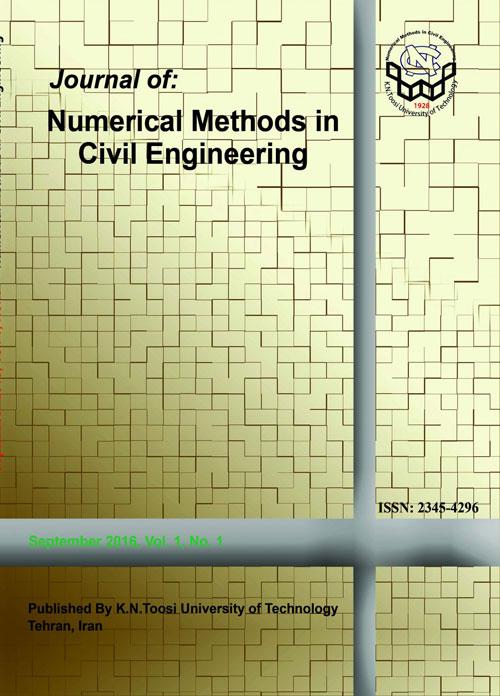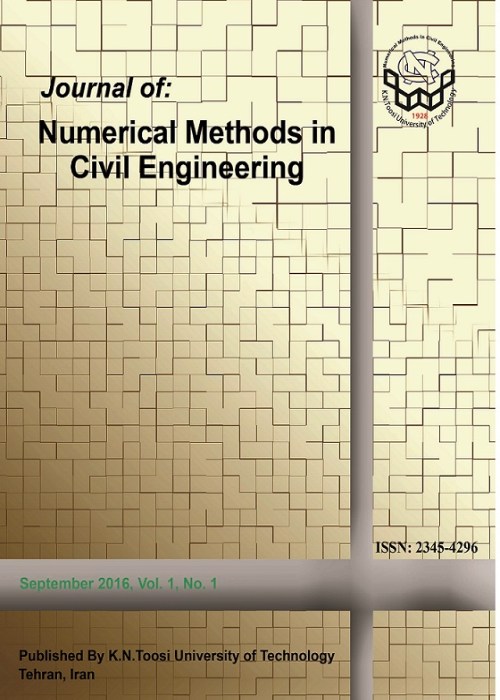فهرست مطالب

Journal of Numerical Methods in Civil Engineering
Volume:2 Issue: 1, Sep 2017
- تاریخ انتشار: 1396/12/20
- تعداد عناوین: 7
-
-
Pages 1-14In the present article, a semi-analytical technique to investigate free bending vibration behavior of axially functionally graded non-prismatic Timoshenko beam subjected to a point force at both ends is developed based on the power series expansions. The beam is assumed to be made of linear elastic and isotropic material with constant Poisson ratio. Material properties including the elastic modulus and mass density vary continuously through the beam axis according to the volume fraction of the constituent materials based on exponential and power-law formulations. Based on Timoshenko beam assumption and using small displacements theory, the free vibration behavior is governed by a pair of second order differential equations coupled in terms of the transverse deflection and the angle of rotation due to bending. According to the power series method, the exact fundamental solutions are found by expressing the variable coefficients presented in motion equations including cross-sectional area, moment of inertia, material properties and the displacement components in a polynomial form. The free vibration frequencies are finally determined by solving the eigenvalue problem of the obtained algebraic system. Four comprehensive examples of axially non-homogeneous Timoshenko beams with variable cross-sections are presented to clarify and demonstrate the performance and convergence of the proposed procedure. Moreover, the effects of various parameters like cross-sectional profile and material variations, taper ratios, end conditions and concentrated axial load are evaluated on free vibrational behavior of Timoshenko beam. The obtained outcomes are compared to the results of finite element analysis in terms of ABAQUS software and those of other available numerical and analytical solutions. The competency and efficiency of the method is then remarked.Keywords: Free transverse vibration Natural frequency Timoshenko beams Axially functionally graded material (AFG) Concentrated axial load Free transverse vibration Natural frequency Timoshenko beams Axially functionally graded material (AFG) Concentrated axial load
-
Pages 15-23The use of Concrete beams reinforced with a combination of fiber reinforced polymer (FRP) and steel bars has increased dramatically in recent years, due to improvement in strength and flexural ductility simultaneously. In this paper, we proposed a new equation for estimating the effective moment of inertia of hybrid FRP-steel reinforced concrete (RC) beams on the basis of the genetic algorithm and experimental results.The genetic algorithm is used to optimize the percent error between experimental and analytical responses. In the proposed equation, additional coefficients are considered in order to take into account the specific properties of FRP bars. The effects of the elastic modulus of FRP and steel bars, the hybrid reinforcement ratio, Af /As, and the different level of loading on the effective moment of inertia has been considered.These coefficients are used to modify Bransons equation to compute the effective moment of inertia of concrete beams reinforced by FRP and steel bars. Comparison between the experimental and predicted results showed the adequacy of the model used in predicting the effective moment of inertia, and deflection of hybrid RC beams.Keywords: Hybrid RC beam, Genetic algorithm, Effective moment of Inertia, FRP bars, Deflection
-
Pages 24-36To control structures against wind and earthquake excitations, Adaptive Neuro Fuzzy Inference Systems and Neural Networks are combined in this study. The control scheme consists of an ANFIS inverse model of the structure to assess the control force. Considering existing ANFIS controllers, which require a second controller to generate training data, the authors approach does not need another controller. To generate control force, active and semi-active devices could be used. Since the active ANFIS inverse controller may not guarantee a satisfactory response due to different uncertainties associated with operating conditions and noisy training data, this paper uses MR dampers as semi-active devices to provide control forces. To overcome the difficulty of tuning command voltage of MR dampers, a neural network inverse model is developed. The effectiveness of the proposed strategy is verified and illustrated using simulated response of the 3-story full-scale nonlinear benchmark building excited by several earthquake records through computer simulation. Moreover, the recommended control algorithm is validated using the wind-excited 76-story benchmark building equipped with MR and TMD dampers. Comparing results with other controllers demonstrates that the proposed method can reduce displacement, drift and acceleration, significantly.Keywords: Control of structure, semi, active control, Adaptive Neuro Fuzzy Inference System, MR damper
-
Pages 37-48This research work presents a new rigid connection constructed with channels. In order to assess its hysteresis behavior, three specimens with different cover plates and six specimens with different panel zone thickness have been considered. The energy absorbed by the connection and the behavior of the panel zone were studied during cyclic loading and compared with those of connection specimens constructed with ribs, as presented in previous researches. Based on the performed analyses, the connection constructed with channels can withstand a rotation of 0.06 radian without considerable strength reduction. In addition, more energy was absorbed in the suggested connection compared to the connection constructed with ribs, while lower rotation was created in the panel zone. Furthermore, the results of the absorbed energy and panel zone rotation are close in both kinds of connection when different lengths of cover plates are used.Keywords: Seismic design, Connections, Steel, Beam to column, Hysteresis
-
Pages 49-60A parametric study approach evaluating drained/undrained behavior of sand has been developed as a simple/quick hypo-elastic model capable of being used in engineering applications. The volumetric interaction of sand grains behavior against pore water pressure induces the tendency of soil mass volume change to contract/dilate due to variation of effective mean stress on solid grain, pore water pressure by compressibility and shear induced dilation/compression which lead to an ideal condition for constant total volume of undrained test. However, any individual volume changes of named components may result in a partial reduction of the effective mean stress to an extent that can be disclosed as a local decrease in stress deviator. In the extreme case, the effective stress components may become so small (or even zero) resulting in complete loss of strength and cause the soil to flow in a manner resembling a liquid known as liquefaction of sand. However, in real case, any possibility of water dissipation or volumetric change tendency of components can change the state/condition to activate some shear strength by increasing the effective mean stress.
The proposed parametric study approach is able to present such volumetric variation condition leading to partial or complete liquefaction condition. This model has predicted and verified several compression triaxial test results of sands. The verification of model is presented by comparing the obtained results with the experimental result of Nevada sand, in both drained and undrained conditions. The proposed model can be successfully used for other soils behavior by using the proposed parametric study method including the required parameters to achieve acceptable results.Keywords: hypo, elastic model, sand, drained, undrained, liquefaction -
Pages 61-71Modal analysis is a powerful technique for understanding the behavior and performance of structures. Modal analysis can be conducted via artificial excitation, e.g. shaker or instrument hammer excitation. Input force and output responses are measured. That is normally referred to as experimental modal analysis (EMA). EMA consists of three steps: data acquisition, system identification and modal parameter estimation. EMA, which is also known as frequency response function (FRF) testing, has been widely preferred for the modal parameter estimation of structures. The main objective of this paper is to determine the locations of damages by applying the wavelet transform to the measured mode shapes. The mode shapes are obtained from EMA by applying FRF of structure as the input data. In the present work, a two-stage method of determining the location of multiple structural damages on space structures is proposed. Firstly, EMA is applied to estimate the first mode shape of space structure by applying FRF as input data. In the second stage the mechanism of using 2D- CWT is applied by exploiting the concept of simulating the mode shape of space structure to a 2D spatially distributed signal for damage localization of space structure. Multiplicities of structural elements and joints are the main challenges related to damage detection of space structure. The validation of EMA is performed with modal assurance criterion (MAC). Seven numerical examples are conducted on two double layer diamatic domes with different sizes to assess the effectiveness of the proposed 2D-CWT method. The results demonstrate the reliability and applicability of the introduced method.Keywords: Damage detection, two dimensional wavelet transform, experimental modal analysis, space structure, frequency response function
-
Pages 72-79This paper presents a method to improve the generation of meshes and the accuracy of numerical solutions of elasticity problems, in which two techniques of h-refinement and enrichment are used by interpolation cover functions. Initially, regions which possess desired accuracy are detected. Mesh improvment is done through h-refinement for the elements existing in those regions. Total error of the domain is thus reduced and limited to the allowable range. In order to increase the accuracy of solutions to an excellent level, the results of mesh refinement are reassessed in the next steps and the nodes exceeding the value of allowable error are determined. The method automatically improves the subdomain by increasing the order of interpolation cover functions which yields to solutions of appropriate accuracy. A comparison of solutions achieved by the proposed method with that of other methods and also the accurate solutions for linear elasticity examples proves acceptable efficiency and accuracy of the proposed method. In this research, we illustrate the power of the strategy through the solutions obtained for various problems.Keywords: mesh refinement, enriched finite elements, mesh generation, interpolation cover functions, adaptive analysis


